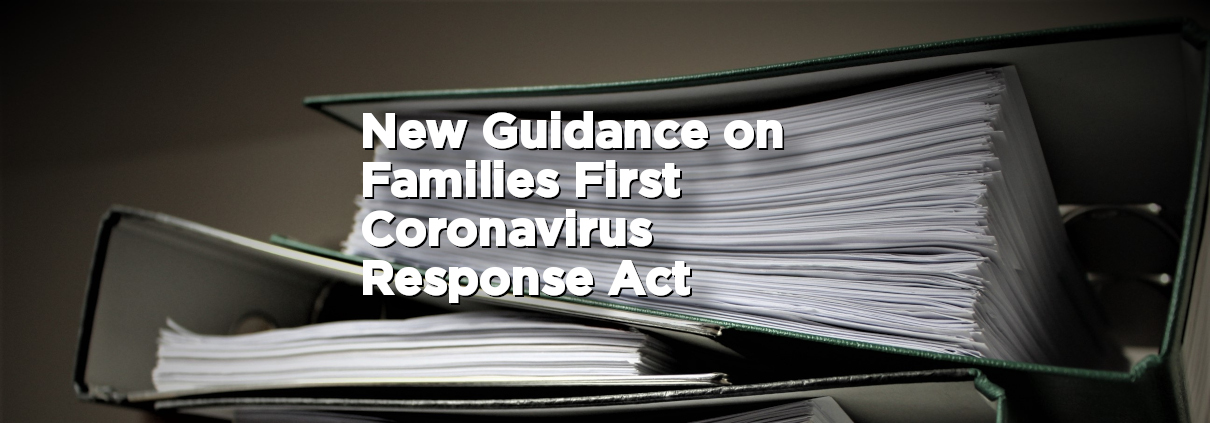New IRS and DOL guidance and regulations regarding the Families First Coronavirus Response Act (FFCRA) plus resources relating to the Coronavirus, Relief, and Economic Security Act (CARES Act)
New IRS Guidance
The IRS issued new guidance on the tax credits available to employers for the paid leave under the Families First Coronavirus Response Act (FFCRA). Some of that guidance relates to the interaction of the FFCRA tax credits and the provisions of the CARES Act (for example, questions 18 and 19). The IRS guidance also addresses That guidance can be found at this link: https://www.irs.gov/newsroom/covid-19-related-tax-credits-for-required-paid-leave-provided-by-small-and-midsize-businesses-faqs. Two items that seems helpful to employers regarding what information they need to document to eligibility for the paid leave and tax credit are questions 44 and 45. The IRS says that in the case of a leave request based on school closing or childcare unavailability, the employee should provide a statement that special circumstances exist for a need to provide care to a child older than 14 during daylight hours (question 44).
New DOL Regulations
The DOL issued 124 pages of new temporary regulations relating to the paid-leave provisions of the FFCRA. Those new regulations can be found at this link: https://www.dol.gov/sites/dolgov/files/WHD/Pandemic/FFCRA.pdf. Note that §826.40(b) at page 103 of those regulations discusses the exemption that an employer with fewer than 50 employee may seek.
DOL Continues to Update Its Guidance Website
The DOL also seems to be continuing to add to its website containing guidance on the FFCRA. It started with 8 pages, then went to 18, and now is 28 pages. That guidance is found at https://www.dol.gov/agencies/whd/ pandemic/ffcra-questions.
CARES Act Resources and Information
For those of you who are considering taking advantage of the loan and loan-forgiveness provisions of the CARES Act that was passed late last week, below are links to some helpful resources. Most businesses with fewer than 500 employees will qualify for the Paycheck Protection Program (PPP) SBA loans — including 501(c) (3) non-profits (including religious organizations) and sole proprietorships or self-employed businesses. The loans are applied for through a local bank, and a link to the PPP borrower application form can be found below. The PPP loans have no personal guarantee or collateral requirements, and all interest and principal payments are deferred for at least six months and up to one year. There are no prepayment penalties, and some or all of the loan can be forgiven if the proceeds are used for payroll and certain other business expenses such as rent, mortgage interest, and utilities.
The way the PPP loans generally work is the business or other entity takes its average monthly payroll costs (full and part time) for the last 12 months (March to March) and then multiplies that by 2.5. That determines the amount of the loan the applicant qualifies for from a local bank. All the lender needs to process is the application (link below) and the applicant’s 12-month trailing payroll history and documentation of related “payroll costs” (including healthcare and retirement benefits, etc.). The bank may be able to turn the loan around in about two weeks for applicants who apply soon. If the borrower uses the loan proceeds (and can document or prove that it did) for rent, mortgage interest, payroll, and utilities for the next 8 weeks, then the SBA forgives those 8 weeks of expenditures and will reimburse the lender accordingly. That can yield for many businesses a near 100% forgiven loan. The loan is a fixed 4% over 10 years if the whole amount is not forgiven.
Importantly for staffing purposes, the forgiveness program includes an incentive for the borrower to rehire laid-off or furloughed employees by the date the borrower receive the funds. If the borrower does not have staffing levels on par with its pre-COVID-19 staffing levels, then the amount of loan forgiveness will be reduced by a defined calculation. So it is wise for the borrower to get back to its pre-COVID-19 staffing levels during the 8 weeks following the loan origination date to receive the full forgiveness benefits.
CARES Act/PPP loan information and resources:
U.S. Chamber of Commerce’s excellent guide to the CARES Act’s Paycheck Protection Program (PPP) SBA loans and loan-forgiveness
provisions: https://www.uschamber.com/sites/default/files/023595_comm_corona_ virus_smallbiz_loan_final.pdf
Full text of the CARES
Act: https://www.law360.com/articles/1257839/attachments/0
Law360 summary of the CARES
Act: https://www.law360.com/articles/1255814/attachments/1
PPP borrower application
form: https://www.sba.gov/sites/default/files/2020-03/Borrower%20Paycheck
%20Protection%20Program%20Application.pdf
U.S. Senate Committee on Small Business and Entrepreneurship
U.S. Senate Committee on Small Business and Entrepreneurship one-page summary: https://www.rubio.senate.gov/public/_cache/files/28e8263e-e7d4-4da7-a67b-077c54ba4220/9F7B494B2E355791B24536DC2162CF16.final-one-pager-keeping-american-workers-paid-and-employed-act-.pdf
U.S. Senate Section-by-Section Summary of Title 1 of the CARES
My partner Tom McKnight has studied the CARES Act, has become very knowledgeable about it, and has discussed it with numerous businesses, so if you have any questions, you can contact either of us about the CARES Act, the FFCRA, or any other issues you are having.
Larry S. Logsdon, Esq. is an attorney with the law firm of Wallace, Jordan, Ratliff & Brandt, L.L.C. and represents subcontractors in the construction industry. He can be reached at llogsdon@wallacejordan.com or (205) 874-0341. For more information visit wallacejordan.com.


